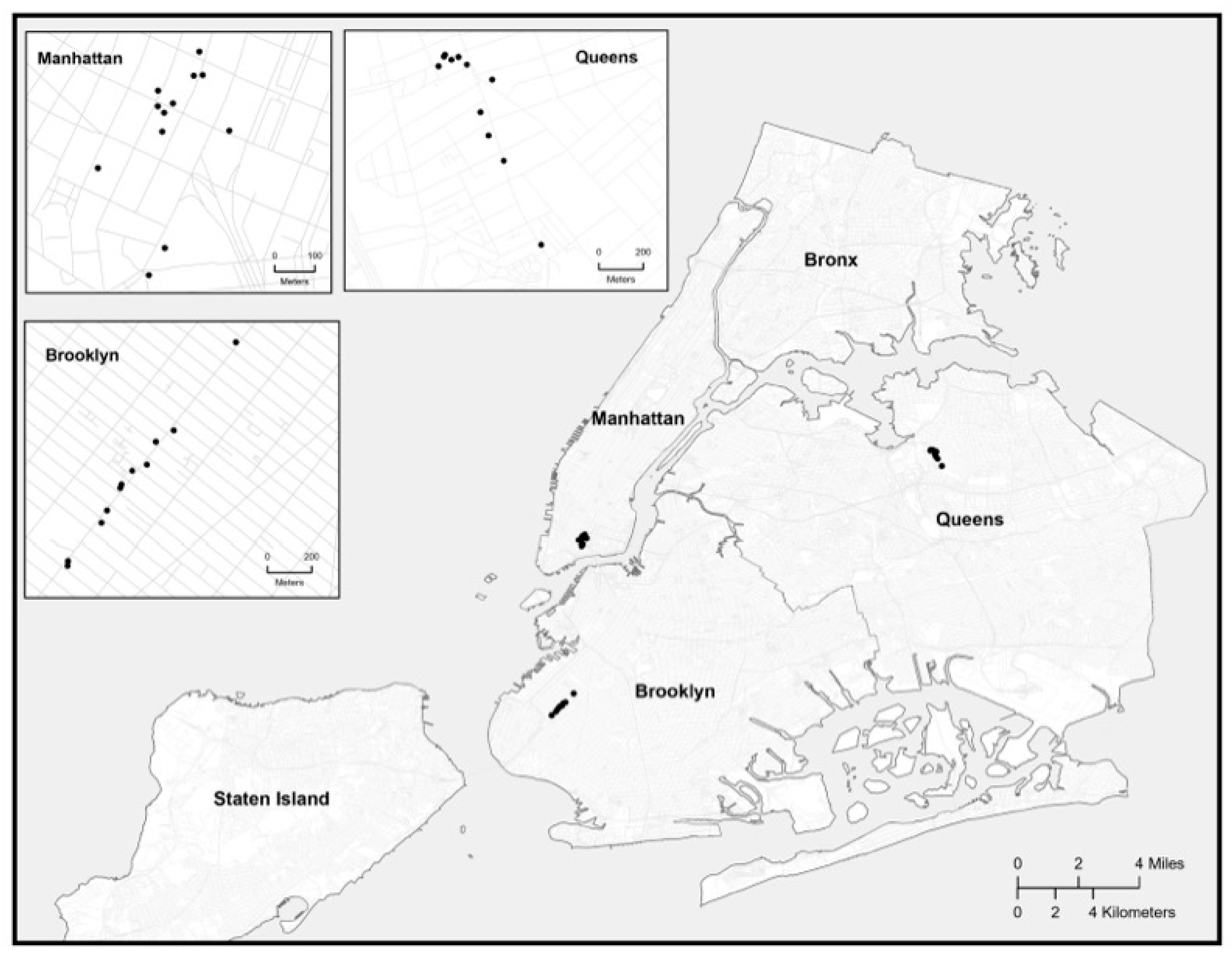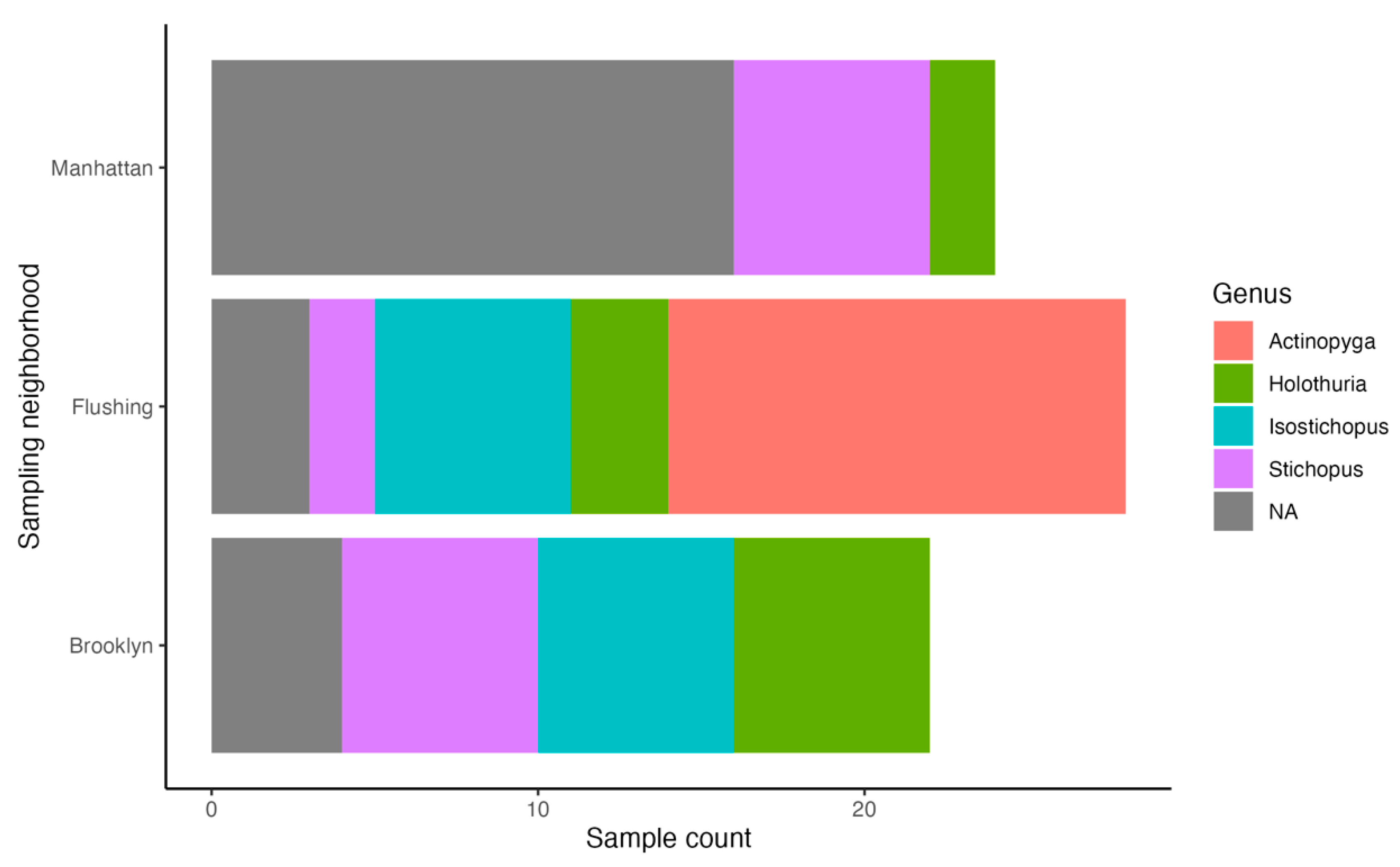Advancing One Health in Urban Seafood Markets: A Genetic and Social Analysis of Dried Sea Cucumber in Three New York City Chinatowns
Abstract
1. Introduction
2. Theory and Context: Urban Metabolism and One Health
3. Materials and Methods
3.1. Site Survey and Interviews
3.2. Sea Cucumber Sampling Procedure
3.3. Genetic Barcoding, Sequencing, and Species Identification
4. Results and Discussion
4.1. Findings from the Genetic Survey
4.2. Findings from Interviews
5. Conclusions
Supplementary Materials
Author Contributions
Funding
Institutional Review Board Statement
Informed Consent Statement
Data Availability Statement
Acknowledgments
Conflicts of Interest
References
- One Health Initiative Task Force. One Health: A New Professional Perspective; American Veterinary Medical Association: Schaumburg, IL, USA, 15 July 2008. [Google Scholar]
- Wolfe, K.; Byrne, M. Overview of the Great Barrier Reef sea cucumber fishery with focus on vulnerable and endangered species. Biol. Conserv. 2022, 266, 109451. [Google Scholar] [CrossRef]
- Purcell, S.W.; Conand, C.; Uthicke, S.; Byrne, M. Ecological roles of exploited sea cucumbers. In Oceanography and Marine Biology; CRC Press: Boca Raton, FL, USA, 2016; pp. 375–394. [Google Scholar]
- Chen, J. Overview of sea cucumber farming and sea ranching practices in China. SPC Beche-De-Mer Inf. Bull. 2003, 18, 18–23. [Google Scholar]
- Chen, J. Present status and prospects of sea cucumber industry in China. Adv. Sea Cucumber Aquac. Manag. 2004, 463, 25–38. [Google Scholar]
- Conand, C.; Polidoro, B.; Mercier, A.; Gamboa, R.; Hamel, J.F.; Purcell, S. The IUCN Red List assessment of aspidochirotid sea cucumbers and its implications. SPC Beche-De-Mer Inf. Bull. 2014, 34, 3–7. [Google Scholar]
- Di Simone, M.; Horellou, A.; Conand, C. The listing of three sea cucumber species in CITES Appendix II enters into force. SPC Bêche-De-Mer Inf. Bull. 2021, 41, 3–4. [Google Scholar]
- IUCN 2022. The IUCN Red List of Threatened Species. Version 2021-3. Available online: https://www.iucnredlist.org (accessed on 1 March 2022).
- De Young, R.W. Genetics and applied management: Using genetic methods to solve emerging wildlife management problems. In Wildlife Science; CRC Press: Boca Raton, FL, USA, 2007; pp. 329–350. [Google Scholar]
- Rimlinger, A.; Avana, M.L.; Awono, A.; Chakocha, A.; Gakwavu, A.; Lemoine, T.; Marie, L.; Mboujda, F.; Vigouroux, Y.; Johnson, V.; et al. Trees and their seed networks: The social dynamics of urban fruit trees and implications for genetic diversity. PLoS ONE 2021, 16, e0243017. [Google Scholar] [CrossRef] [PubMed]
- Rodenbiker, J.; Therkildsen, N.O.; Li, C.C. Global Shark Fins in Local Contexts: Multi-scalar Dynamics Between Hong Kong Markets and Mid-Atlantic Fisheries. Ecol. Soc. 2023, 28. [Google Scholar] [CrossRef]
- Cronon, W. Nature’s Metropolis; WW Norton: New York, NY, USA, 1991. [Google Scholar]
- Davis, M. Ecology of Fear: Los Angeles and the Imagination of Disaster; Macmillan: New York, NY, USA, 1998. [Google Scholar]
- Gandy, M. Concrete and Clay: Reworking Nature in New York City; MIT Press: Cambridge, MA, USA, 2002. [Google Scholar]
- Swyngedouw, E. Social Power and the Urbanization of Water: Flows of Power; Oxford University Press: Oxford, UK, 2004. [Google Scholar]
- Heynen, N.; Kaika, M.; Swyngedouw, E. In the Nature of Cities. Urban Political Ecology and the Politics of Urban Metabolism; Routledge Taylor and Francis Group: London, UK; New York, NY, USA, 2006. [Google Scholar]
- Brenner, N. Theses on urbanization. Public Cult. 2013, 25, 85–114. [Google Scholar] [CrossRef]
- Saguin, K.K. Urban Ecologies on the Edge: Making Manila’s Resource Frontier; University of California Press: Berkeley, CA, USA, 2022. [Google Scholar]
- Rodenbiker, J. Urban oceans: Social differentiation in the city and the sea. Environ. Plan. E Nat. Space 2023, 6, 412–432. [Google Scholar] [CrossRef]
- Gibbs, E.P.J. The evolution of One Health: A decade of progress and challenges for the future. Vet. Rec. 2014, 174, 85–91. [Google Scholar] [CrossRef]
- Garcia, S.N.; Osburn, B.I.; Jay-Russell, M.T. One health for food safety, food security, and sustainable food production. Front. Sustain. Food Syst. 2020, 4, 1. [Google Scholar] [CrossRef]
- Kleisner, K.M.; Longo, C.; Coll, M.; Halpern, B.S.; Hardy, D.; Katona, S.K.; Le Manach, F.; Pauly, D.; Rosenberg, A.A.; Samhouri, J.F.; et al. Exploring patterns of seafood provision revealed in the global Ocean Health Index. Ambio 2013, 42, 910–922. [Google Scholar] [CrossRef] [PubMed][Green Version]
- Clarke, S. Understanding pressures on fishery resources through trade statistics: A pilot study of four products in the Chinese dried seafood market. Fish Fish. 2004, 5, 53–74. [Google Scholar] [CrossRef]
- To, A.W.; Shea, S.K. Patterns and dynamics of bêche-de-mer trade in Hong Kong and mainland China: Implications for monitoring and management. Traffic Bull. 2012, 24, 65–76. [Google Scholar]
- Purcell, S.W.; Mercier, A.; Conand, C.; Hamel, J.F.; Toral-Granda, M.V.; Lovatelli, A.; Uthicke, S. Sea cucumber fisheries: Global analysis of stocks, management measures and drivers of overfishing. Fish Fish. 2013, 14, 34–59. [Google Scholar] [CrossRef]
- Cheung, H.; Doughty, H.; Hinsley, A.; Hsu, E.; Lee, T.M.; Milner-Gulland, E.J.; Possingham, H.P.; Biggs, D. Understanding Traditional Chinese Medicine to strengthen conservation outcomes. People Nat. 2021, 3, 115–128. [Google Scholar] [CrossRef]
- Fabinyi, M. Historical, cultural and social perspectives on luxury seafood consumption in China. Environ. Conserv. 2012, 39, 83–92. [Google Scholar] [CrossRef]
- Eriksson, H.; Clarke, S. Chinese market responses to overexploitation of sharks and sea cucumbers. Biol. Conserv. 2015, 184, 163–173. [Google Scholar] [CrossRef]
- Purcell, S.; Polidoro, B.; Hamel, J.; Gamboa, R.; Mercier, A. The cost of being valuable: Predictors of extinction risk in marine invertebrates exploited as luxury seafood. Proc. Biol. Sci. 2014, 281, 20133296. [Google Scholar] [CrossRef]
- Pangestuti, R.; Arifin, Z. Medicinal and health benefit effects of functional sea cucumbers. J. Tradit. Complement. Med. 2018, 8, 341–351. [Google Scholar] [CrossRef]
- Xing, R.-R.; Hu, R.-R.; Wang, N.; Zhang, J.-K.; Ge, Y.-Q.; Chen, Y. Authentication of sea cucumber products using NGS-based DNA mini-barcoding. Food Control 2021, 129, 108199. [Google Scholar] [CrossRef]
- Anderson, K.J. The idea of Chinatown: The power of place and institutional practice in the making of a racial category. Ann. Assoc. Am. Geogr. 1987, 77, 580–598. [Google Scholar] [CrossRef]
- Tchen, J.K.W. New York before Chinatown: Orientalism and the Shaping of American Culture, 1776–1882; Johns Hopkins University Press: Baltimore, MD, USA, 2001. [Google Scholar]
- Byrnes, C. Transpacific Maladies. Soc. Text 2020, 38, 1–26. [Google Scholar] [CrossRef]
- Gao, Q.; Liu, X. Stand against anti-Asian racial discrimination during COVID-19: A call for action. Int. Soc. Work 2021, 64, 261–264. [Google Scholar] [CrossRef]
- Gover, A.R.; Harper, S.B.; Langton, L. Anti-Asian hate crime during the COVID-19 pandemic: Exploring the reproduction of inequality. Am. J. Crim. Justice 2020, 45, 647–667. [Google Scholar] [CrossRef] [PubMed]
- Rodenbiker, J. China’s Global Reach: Urban Social Lives of the More-than-Human. Soc. Space 2020, 8. [Google Scholar]
- Longhurst, R. Semi-structured interviews and focus groups. Key Methods Geogr. 2003, 3, 143–156. [Google Scholar]
- Yang, Z.; Rannala, B. Molecular phylogenetics: Principles and practice. Nat. Rev. Genet. 2012, 13, 303–314. [Google Scholar] [CrossRef] [PubMed]
- Wen, J.; Hu, C.; Zhang, L.; Fan, S. Genetic identification of global commercial sea cucumber species on the basis of mitochondrial DNA sequences. Food Control 2011, 22, 72–77. [Google Scholar] [CrossRef]
- Kučka, M.; Chan, F.Y. HMW DNA Extraction Using Magnetic Beads. Protocols.io. 2022. Available online: https://www.protocols.io/view/hmw-dna-extraction-using-magnetic-beads-b46bqzan (accessed on 4 February 2024).
- Byrne, M.; Rowe, F.; Uthicke, S. Molecular taxonomy, phylogeny and evolution in the family Stichopodidae (Aspidochirotida: Holothuroidea) based on COI and 16S mitochondrial DNA. Mol. Phylogenetics Evol. 2010, 56, 1068–1081. [Google Scholar] [CrossRef]
- Mercier, A.; Hamel, J.-F.; Toral-Granda, T.-G.; Alvarado, J.J.; Paola Ortiz, E.; Benavides, M. Isostichopus fuscus. IUCN Red List. Threat. Species 2013, e.T180373A1621878. [Google Scholar] [CrossRef]
- Samyn, Y. Holothuria tubulosa. IUCN Red List. Threat. Species 2013, e.T180455A1632895. [Google Scholar] [CrossRef]
- CITES. Checklist of CITES Species. 2020. Available online: https://checklist.cites.org (accessed on 4 February 2024).
- Ramírez-González, J.; Moity, N.; Andrade-Vera, S.; Reyes, H. Overexploitation and more than a decade of failed management leads to no recovery of the Galápagos sea cucumber fishery. Front. Mar. Sci. 2020, 7, 554314. [Google Scholar] [CrossRef]
- Martinsohn, J.T.; Ogden, R. FishPopTrace—Developing SNP-based population genetic assignment methods to investigate illegal fishing. Forensic Sci. Int. Genet. Suppl. Ser. 2009, 2, 294–296. [Google Scholar] [CrossRef]
- Baetscher, D.S.; Locatelli, N.S.; Won, E.; Fitzgerald, T.; McIntyre, P.B.; Therkildsen, N.O. Optimizing a metabarcoding marker portfolio for species detection from complex mixtures of globally diverse fishes. Environ. DNA 2023, 5, 1589–1607. [Google Scholar] [CrossRef]
- Fabinyi, M.; Liu, N. Seafood banquets in Beijing: Consumer perspectives and implications for environmental sustainability. Conserv. Soc. 2014, 12, 218–228. [Google Scholar] [CrossRef]
- Chee, L.P. Mao’s Bestiary: Medicinal Animals and Modern China; Duke University Press: Durham, NC, USA, 2021. [Google Scholar]
- Ren, A.; Zhao, X.; Liu, Q.; Yu, L.; Han, F.; Jia, F.; Hou, H.; Liu, Y. Green Supplier Assessment and Selection for Sea Cucumber (Apostichopus japonicus) Processing Enterprise: Case Study in China. Sustainability 2023, 15, 15368. [Google Scholar] [CrossRef]
- Ben-Hasan, A.; de Mitcheson, Y.S.; Cisneros-Mata, M.A.; Jimenez, E.A.; Daliri, M.; Cisneros-Montemayor, A.M.; Nair, R.J.; Thankappan, S.A.; Walters, C.J.; Christensen, V. China’s fish maw demand and its implications for fisheries in source countries. Mar. Policy 2021, 132, 104696. [Google Scholar] [CrossRef]
- de Mitcheson, S.Y.; To, A.W.L.; Wong, N.W.; Kwan, H.Y.; Bud, W.S. Emerging from the murk: Threats, challenges and opportunities for the global swim bladder trade. Rev. Fish Biol. Fish. 2019, 29, 809–835. [Google Scholar] [CrossRef]


Disclaimer/Publisher’s Note: The statements, opinions and data contained in all publications are solely those of the individual author(s) and contributor(s) and not of MDPI and/or the editor(s). MDPI and/or the editor(s) disclaim responsibility for any injury to people or property resulting from any ideas, methods, instructions or products referred to in the content. |
© 2024 by the authors. Licensee MDPI, Basel, Switzerland. This article is an open access article distributed under the terms and conditions of the Creative Commons Attribution (CC BY) license (https://creativecommons.org/licenses/by/4.0/).
Share and Cite
Rodenbiker, J.; Therkildsen, N.O.; Ruan, E.; Su, K. Advancing One Health in Urban Seafood Markets: A Genetic and Social Analysis of Dried Sea Cucumber in Three New York City Chinatowns. Sustainability 2024, 16, 3589. https://doi.org/10.3390/su16093589
Rodenbiker J, Therkildsen NO, Ruan E, Su K. Advancing One Health in Urban Seafood Markets: A Genetic and Social Analysis of Dried Sea Cucumber in Three New York City Chinatowns. Sustainability. 2024; 16(9):3589. https://doi.org/10.3390/su16093589
Chicago/Turabian StyleRodenbiker, Jesse, Nina Overgaard Therkildsen, Erica Ruan, and Kelly Su. 2024. "Advancing One Health in Urban Seafood Markets: A Genetic and Social Analysis of Dried Sea Cucumber in Three New York City Chinatowns" Sustainability 16, no. 9: 3589. https://doi.org/10.3390/su16093589
APA StyleRodenbiker, J., Therkildsen, N. O., Ruan, E., & Su, K. (2024). Advancing One Health in Urban Seafood Markets: A Genetic and Social Analysis of Dried Sea Cucumber in Three New York City Chinatowns. Sustainability, 16(9), 3589. https://doi.org/10.3390/su16093589





